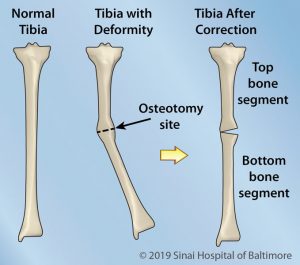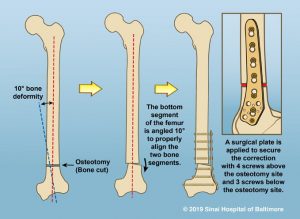Correction Of Deformities
What is deformity correction?
Deformity repair is a technique that straightens a bone that has been bent or twisted in an abnormal way. The arm, leg, or foot returns to normal alignment and function when the bones is straightened. There are two methods for correcting deformities:
- During a surgical operation, everything happens at once
- Slowly, over a period of several weeks or months
How does acute deformity correction work?
Throughout surgery, the doctor cuts the bone to divide two different bone pieces. An osteotomy is a surgical operation used to cut a bone. The doctor will then straighten the bone. After the bone has been properly positioned, the doctor implants an inside device to hold it in the correct place while it heals. The interior device might be a nail/rod or a metal plate. Additional soft-tissue treatments may be performed concurrently to enable the muscle to adapt the repair. The internal gadget may be replaced during a second operation when the bone has healed. To straighten the bone, the doctor may utilise fixator-assisted riveting or fixator-assisted plate in some cases. During surgery, an external fixator is temporarily used to retain the bone segments in precise alignment while an internal nail, rod, or plate is inserted. When the procedure is finished, the exterior fixator is eliminated, but the surgical treatment remains.


How does gradual deformity correction work?
An external fixator is used to secure the bone during surgery. The bone would then be sliced (osteotomy) into two distinct bone pieces, and soft-tissue treatments may be performed to arrange the muscular system.
Following surgery, the client will be provided precise instructions and a timetable for adjusting the external fixator to gradually straighten the bone. This prolonged process of gradually separating and aligning the bone parts is known as distraction, which translates as “drawing apart.” New bone grows in the distance between two bone segments as they are gently dragged apart and straightened. The new tissue is known as regenerate bone.
During the diversion phase, the orthopaedic device is adjusted regularly, if not several times a day, to draw the bone sections apart and straighten them at a slow rate of around 1 mm (0.04 inches) every day. This drives the body to continually generate new bone and soft tissue, including skin, bones, nerves, and blood vessels. The distraction phase continues until the bone is straightened or rectified. During the distraction phase, the client will must see the surgeon every 10 to 14 days and will begin a rigorous physical therapy routine.
The diversion phase followed by the stabilization phase, in which the regenerate bone hardens gradually. When the regenerate bone has completely hardened and calcified, it is consolidated (“healed”). Typically, the consolidation phase lasts twice as long as the distraction period. For instance, if distraction takes one month, integration will take two months. This implies that in this case, the external fixator would be worn by the patients for a total of three months, during the diversion and consolidation stages.
To aid bone healing, patients should avoid all forms of nicotine, consume enough of protein, and take multivitamin. Throughout this stage, your doctor may recommend you to begin putting pressure on the arm/leg to assist the bone to solidify and mend. The exterior fixator is released during an outpatient surgical procedure when the regenerate bone has fully hardened
What types of orthopedic devices can be used for deformity correction?
We utilise a number of orthopaedic devices to address bone abnormalities at the Kothari Hospital . We determine which gadget will work best for each individual depending on their specific scenario. Please see Lengthening & Deformity Correcting Devices for further information on individual devices.
What happens if the bone is straightened too slowly during gradual correction?
If the bones is straightened too gently, it may heal before it is completely straightened. To avoid early consolidation, the surgeon will wish to see the patient often (every two or three weeks) during the diversion period.
Despite the fact that the average rate of correction is 1 mm each day, each person reacts differently to bones lengthening. Some people’s bones recover fast, and the regenerated bone may solidify before the treatment is finished. This is known as premature consolidation. When regenerated bone solidifies too rapidly, it may heal before it is totally straight and aligned.
X-rays can identify the early phases of premature consolidation. When this occurs, one alternative is to increase the pace at which the bone sections are pushed apart. For instance, the client may be instructed to raise the pace of attention from 1 mm per day to 2 mm per day. If the regenerated bone has completely solidified, it may have to be surgically sliced again in order for lengthening to proceed.
What happens if the bone is straightened too quickly during gradual correction?
Early stages of premature consolidation can be detected using X-rays. When this happens, one option is to accelerate the rate at which the bone parts are pushed apart. For example, the customer may be told to increase the rate of attentiveness from 1 mm per day to 2 mm per day. If the recovered bone has entirely cemented, it may need to be surgically cut again before lengthening can begin.
Despite the fact that the average rate of separation is 1 mm each day, some people’s fractures take longer to repair. During the tension stage, regenerate bone must grow in order to function as an integration between different bone segments.
When the regenerated bone is not growing, one non-surgical method is to change the orthopaedic device to momentarily short the bones till the regenerate bone develops, allowing the healing to “catch up.” Inserting bone tissue (called a bones graft) to encourage bone formation is one surgical approach for assisting the body in creating new bone. The doctor will enable the patient to continue fixing the bone when the regeneration begins to fill between the bone pieces.
Another difficulty that might arise during diversion is that the soft tissues (muscles, nerves, ligaments, and tendons) may resist stretching, causing them to become extremely tight. Extending these muscles and nerves during physiotherapy sessions is a non-surgical method for treating tight muscles and nerves. Throughout the distraction process, the patient will be told to go to physical therapy many times each week. Muscular contractures can potentially be surgically corrected if necessary.
If a nerve is “pinched” or squeezed as a result of the distracting process, a surgical technique known as nerve decompression can be used to relieve pressure on the median nerve.
What could prevent a bone deformity from being corrected?
Patients’ muscular strength and flexion may suffer if they do not visit physiotherapy sessions or execute their home exercises, and the doctor may advise them to discontinue treatment. Muscle stiffness or nerve difficulties may potentially prompt the doctor to halt the deformity repair procedure.
Do arms and legs that had deformity correction function well after treatment?
Adults and children typically have very active lives after deformity correction. Our patients have achieved increased function (better walking/gait), improved muscle strength and maintained their range of motion (flexibility). A large part of the success depends on having experienced surgeons, support staff and physical therapists working together with motivated patients through every stage of the process.
The role of physical therapy cannot be over-emphasized; patients may need to attend physical therapy sessions multiple times per week to maintain range of motion (flexibility) and muscle strength during the distraction phase. Our physical therapists have years of experience in this highly specialized type of therapy and have developed unique methods and splints geared to make the treatment more successful.
Why choose the International Center for Limb Lengthening?
The International Center for Limb Lengthening is world-renowned for its expertise in limb deformity correction. Your doctor at the International Center for Limb Lengthening will take the time to make sure you understand all of your options and then will customize your treatment to meet your specific needs. Our patients benefit from our team-centered approach with world-renowned pediatric and adult orthopedic surgeons and specialized physician assistants, nurses and physical therapists. We help patients in need of deformity correction achieve their best possible result.
